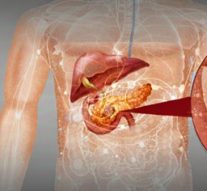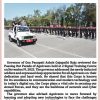Goa is abuzz with excitement as vintage bike and car owners, users, collectors and fans are decking […]

Pancreatic Cancer: The Rise of the Silent Killer
Uncategorized November 28, 2025Understand the whispers of pancreatic cancer as we observe Pancreatic Cancer Awareness Month in November. It may be remembered that among the victims of the cancer was the late chief minister, Manohar Parrikar. Dr Amit Dias shares the early signs to look out for and the need to take immediate action….
By Dr Amit Dias
PANCREATIC Cancer is often described as a silent killer — not because it is rare, but because it rarely speaks loudly until it is too late. As we observe Pancreatic Cancer Awareness month in November and dedicate November 20 to the cause, let us use this opportunity to enlighten ourselves on this inconspicuous yet deadly disease.
The pancreas sits hidden deep within the abdomen, and its cancers are notorious for whispering subtle signs before striking with full force. The numbers are slowly rising. By now, you would have heard of someone who was affected by pancreatic cancer, we need to detect it early. Understanding these whispers — the early clues, the risk factors, and the growing global burden — is key to addressing a cancer that demands urgent public attention.
The hidden organ with a lot of responsibility
The pancreas is an elongated gland tucked behind the stomach. Despite its modest size, it performs two vital tasks:
• Digestive function – It produces enzymes that break down fats, proteins, and carbohydrates in the small intestine.
• Hormonal function – It secretes insulin and glucagon, which regulate our blood sugar levels.
Because its roles are central to both nutrition and metabolism, any disease affecting the pancreas — including cancer — can have widespread effects on digestion, weight, blood sugar, and overall wellbeing.
When the cells go malignant
MOST pancreatic cancers arise from the exocrine part of the pancreas, especially the ducts. These tumours grow quietly in the early stages. Symptoms often appear only when the cancer has spread or obstructed nearby structures, making early diagnosis a challenge. This silent progression contributes to the high mortality associated with the disease and underscores the importance of awareness.
A Growing Global Concern
PANCREATIC cancer is not the most common cancer, but it is among the deadliest. Worldwide, hundreds of thousands of new cases are diagnosed each year, and the number is rising. Ageing populations, improved diagnostic capacity, and lifestyle-related risk factors have contributed to a steady increase in incidence. Alarmingly, the number of deaths is nearly equal to the number of new cases, reflecting how unforgiving this cancer can be once established.
Who Is at Risk?
Anyone can develop pancreatic cancer, but the risk is higher in:
• Older adults, particularly those over 60.
• Men, who show a slightly higher incidence than women.
• People with long-standing diabetes, metabolic syndrome, or insulin resistance.
• Smokers, as tobacco remains a strong preventable risk factor.
• Individuals with obesity or sedentary lifestyles.
• People with chronic pancreatitis, often linked to heavy alcohol consumption.
• Those with a family history or inherited genetic mutations such as BRCA mutations or specific hereditary syndromes.
These factors mean that pancreatic cancer is shaped both by genetics and lifestyle — a combination of what we inherit and what we are exposed to.
Why Are Cases Increasing?
Several forces are driving the rise:
• An ageing population, since risk increases sharply with age.
• Increasing rates of obesity and type 2 diabetes, both known risk factors.
• Lifestyle changes, including tobacco use and dietary patterns.
• Better detection and reporting, which means more cases are now correctly identified.
Together, these factors have made pancreatic cancer a growing public health challenge.
Listen to the Whispers: Recognising the Early Signs
EARLY signs of pancreatic cancer are subtle and often mistaken for common gastrointestinal or metabolic issues. However, certain symptoms — especially if persistent — should prompt medical attention:
• Unexplained weight loss or loss of appetite.
• Persistent upper abdominal pain or pain radiating to the back.
• New-onset diabetes, particularly in people over 50 without a strong family history.
• Jaundice, caused when a tumour blocks the bile duct.
• Persistent indigestion, nausea, or changes in stool such as pale, greasy stools.
• Sudden worsening of existing diabetes or difficulty controlling blood sugar.
These signs do not always mean cancer, but their persistence, especially in combination, warrants a thorough evaluation. Early suspicion and prompt imaging can make a critical difference in catching the disease at a more treatable stage.
In fact, I would take this opportunity to caution you about the cancers in general – remember the word CAUTION
C – Change in bowel or bladder habits
A – A sore that does not heal
U – Unusual bleeding or discharge
T – Thickening or lump in the breast or elsewhere
I – Indigestion or difficulty swallowing
O – Obvious change in a wart or mole
N – Nagging cough or hoarseness
Preventing Pancreatic Cancer — What You Can Do
While not all cases can be prevented, several steps significantly reduce risk:
• Quit smoking – Tobacco is one of the strongest modifiable risk factors. Tobacco doubles the risk of getting it.
• Maintain a healthy weight – Through balanced diet and regular exercise.
• Control diabetes effectively – Good metabolic control lowers risk.
• Limit heavy alcohol use – To prevent chronic pancreatitis.
• Eat wisely – A diet rich in fruits, vegetables, whole grains, and low in processed foods supports overall metabolic health.
• Genetic counselling – Individuals with strong family histories or known mutations may benefit from targeted surveillance.
Prevention is a blend of personal habits, public health policy, and genetic insight.
Turning Awareness Into Action
PANCREATIC Cancer Day is a reminder that silence should not translate into neglect. Awareness helps people recognise symptoms earlier, seek timely medical help, adopt healthier lifestyles, and support research and advocacy. The fight against pancreatic cancer requires a collective effort — clinicians, researchers, policymakers, and communities working together.
Conclusion — Breaking the Silence
PANCREATIC cancer may be a silent killer, but our response must not be silent. By recognising early signs, acting on risk factors, and strengthening prevention and research efforts, we can change the trajectory of this disease. Understanding the whispers of pancreatic cancer may well be the key to saving lives — today, and in the years ahead. With improving cancer care there is hope.















